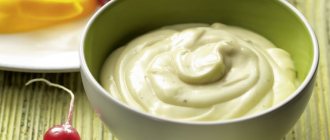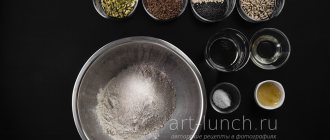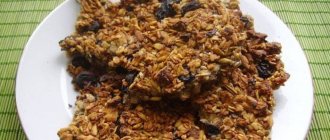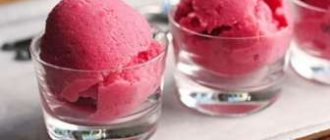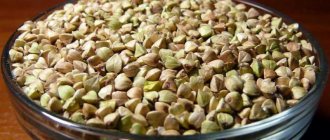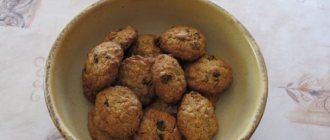Cherry, strawberry, raspberry and, of course, orange marmalade are a favorite delicacy of our childhood, with which warm memories are invariably associated. Unfortunately, modern sweets sold in stores are far from the ones we loved so much. They contain a large number of preservatives, dyes and other additives. But it’s not difficult to treat yourself to your favorite delicacy with a good composition, because homemade marmalade is easy to make yourself.
For preparation, you will need pectin, because it is this gelling additive that is used in the classic marmalade recipe.
Pectin is a natural thickener that is obtained from apples, citrus fruits, beets and other fruits and vegetables. It contains a large amount of useful substances, so it is often used in the production of products for children or people with diabetes.
Typically, homemade marmalade is made from apples, since they already contain pectin and do not need to be added additionally. If you decide to make a delicacy from cherries, red or black currants, gooseberries, blueberries or other berries, you will need a gelling additive. You can buy high-quality pectin on our website 100ing.ru, where you can find a large selection of pectin from apples and citrus fruits, as well as other thickeners at competitive prices. For the convenience of customers, the website offers fast delivery throughout Russia and pickup (via the Boxberry delivery service).
PP marmalade - dietary recipe with gelatin
- 350 grams of mango. This fruit is ideal for making tender and tasty marmalade. In this case, the amount of already peeled fruit is indicated.
- 15 grams of gelatin. It is best to use instant gelatin, so the cooking process will take much less time.
- 250 grams of water
- 2 scoops of fitparad
Pour gelatin into 100 ml of water, warm it up a little and add fitparad. The sweetener should dissolve properly in the gelatin. Blend the peeled mango using a blender. We need to get fruit puree of uniform consistency. Pour the remaining water into the resulting puree, mix thoroughly and combine with the gelatin mass. Now all that remains is to pour our dietary marmalade into molds and put it in the freezer.
Marmalade with agar-agar at home
- 200 grams of currants. You can use any other berry at your discretion.
- 1 teaspoon agar-agar. This natural product is an excellent replacement for gelatin. Agar-agar is obtained from seaweed and is used in cooking to prepare various desserts and dishes.
- 250 ml water
- Any sweetener.
The first step is to soak the agar-agar in a glass of water. Leave for 40-50 minutes. Using a blender, beat the currants into puree, add any sweetener to your taste. When the agar-agar has brewed, put it on low heat and, stirring gently, wait until it completely dissolves. There is no need to bring the mixture to a boil. Add berry puree to the prepared agar-agar mixture and stir. Our low-calorie marmalade can be poured into molds!
Apple marmalade in the microwave. Homemade apple marmalade baked in the microwave
Kiev resident Dmitry Ostakhov often prepares homemade apple marmalade for his wife and children. He shares the recipe with a Gazeta.ua correspondent.
“You don’t need any sugar at all to make homemade marmalade. This is much more useful. In addition, I prepare the product using a simple and reliable method. I cut the apples into medium-sized pieces and put them in a bowl that is suitable for heating in the microwave. I heat them up at maximum power. There is no need to remove the core or peel of the apples. Before this, I pour a glass of water over a kilogram of apples,” says the man.
“After 25 minutes of intensive heating in the microwave, I take out the apples. I stir, place in parts in a colander and grind. If the mass turns out to be thick, you can add a little water to it. I put the pureed apples back in the microwave and bring to a boil, again at full power. From time to time you need to take out the mold and stir the puree. I continue to cook until the level has reduced by about three times. During this time, the mass should become increasingly dense."
If you want to make the marmalade sweeter, you can add sugar to taste in short intervals between heating. The later you add it, the milder the taste will be. But if you add sugar from the very beginning of cooking, it can give a slightly burnt taste."
“As soon as the mass becomes dense, I pour it into boxes. In this case, in ordinary food containers 4 centimeters thick. Leaving them open for 2-3 days so that the mass first cools and then thickens well. After this, the marmalade, which has “set”, can be easily removed from the box. But such marmalade is not yet very strong, so it breaks easily and sticks to your fingers. It needs to be dried a little. In winter, I dried it on the radiator, but when the heating was turned off, I left it for another two days near the stove, which was turned on from time to time to prepare other dishes. The heat helps the marmalade dry out."
» At the final stage of cooking, the marmalade becomes dark brown and very dense. It can be cut if you put some effort into it and holds its shape well. Marmalade cubes can be stored for a long time in boxes lined with paper napkins.”
Stevia marmalade
- 200 - 300 ml apple juice without sugar. In principle, you can use absolutely any natural juice when preparing pp marmalade. The main condition is the absence of sugar.
- 20−30 grams of gelatin. Can be replaced with agar-agar if desired.
- Stevia according to your taste.
You'll love this versatile low-calorie marmalade recipe. If you can’t always find fruits and berries on store shelves, you can always find juice. Pour the juice into a saucepan and place on low heat. Add stevia to taste and gelatin. Cook, stirring, until the gelatin is completely dissolved. Do not bring to a boil! All we have to do is pour it into molds and cool. Diet marmalade is ready!
Who invented marmalade
It is generally accepted that this dietary marmalade was invented by the French, but initially marmalade was prepared in the countries of the East and the Mediterranean: in this way it was more convenient to process and store abundant harvests of fruits and berries in hot climates.
In Europe, they learned about marmalade from the crusading knights, during the era of the famous campaigns - before that, Europeans didn’t even have sugar, but around the 14th century they began to try to create their own delicacy. Of course, the French quickly succeeded by learning to prepare different types: thick and soft marmalade, stretchy, with glaze, gelled, etc. The basis was quince jam - it was called “marmelade”, and other components were added later.
Artificial pectin appeared in the 19th century, and in the 20th century they began to make marmalade “from anything”: in stores you can now see products of unimaginable colors and with any flavors, but most of them can hardly be called natural.
Vegetable diet for weight loss
Diet marmalade with skim milk
- 200 grams of milk. You can use 1% or 0.5% fat milk.
- Any sweetener to taste.
- 15 grams of gelatin.
- A little vanilla essence.
- 100 ml water. We will dissolve gelatin in it.
First, soak the gelatin in water for 20-30 minutes. Add sweetener to taste and a little vanilla to skim milk. Heat the milk and add gelatin to it and mix thoroughly. All that remains is to pour the low-calorie marmalade into molds and you can enjoy the milk dessert.
Pumpkin marmalade with agar-agar
To prepare this dessert you will need:
- 250 grams of boiled pumpkin puree. It is best to beat the puree in a blender so that it is completely homogeneous.
- 1.5 teaspoons agar-agar. It needs to be soaked in 50 ml of water for several hours.
- Any sweetener to your taste.
- A little cinnamon for flavor.
We put agar-agar on low heat, add sweetener there and cook a little, without bringing to a boil. Then remove from heat and pour the mixture into the pumpkin puree, stirring constantly. You can do this with a mixer. We also put a little cinnamon in there. Pour into molds and place in the refrigerator for 1 hour!
Orange marmalade - recipe with agar-agar
Do you like oranges? Then here is a great dessert recipe:
- 2 large oranges. Squeeze out the juice, on average you will get about 150-200 ml. You can take ready-made juice, but most likely it will contain sugar, and if you adhere to pp, then it is better to use healthy products.
- Any sweetener to your taste.
- 5 grams of agar-agar.
Divide the juice into two parts, so that one contains 50 ml. Add agar-agar to the smaller part and leave to swell a little. Mix the rest of the juice with sweetener and put on fire. As soon as the mixture begins to boil, add the second part of the juice with agar-agar. Bring to a boil and remove from heat. All that remains is to pour the marmalade and put it in the refrigerator!
Sugar-free apple marmalade - recipe
For applesauce lovers, there is a great recipe for sugar-free marmalade:
- 700 grams of apples. Wash, peel, peel and bake in the oven. Then blend in a blender until a smooth puree is obtained.
- Any sweetener to your taste.
- 7 grams of agar-agar.
- 250 ml water.
- 100 grams of orange juice. We will dilute agar-agar in it.
First of all, add agar-agar to the juice and leave for 30 minutes.
Place applesauce in a separate container, add water and sweetener to your taste. Cook over low heat. As soon as it starts to boil, add agar-agar and let it simmer for another 4-5 minutes. Then pour into molds and put in the refrigerator.
Sugar-free chewing marmalade
Do you like chewing marmalade? You can always prepare it at home in seconds!
- 1 cup of any natural juice. You can use lemon juice if you like sourness, or orange juice.
- 3 tablespoons gelatin.
- Any sweetener. We will use erythritol - 3 tsp.
Mix all the ingredients in one container and put on fire. Cook over low heat until the gelatin is completely dissolved. Don't boil, this is important! Pour and refrigerate for just 15 minutes!
As you can see, pp marmalade recipes are incredibly easy to prepare. You can treat yourself and your loved ones with a wonderful low-calorie dessert at any time! Prepare pp marmalade and share your recipes!
When you are on a diet, it is especially difficult to give up sweets. Nutrition experts do not recommend completely eliminating desserts from your diet. Low-calorie options can be a good alternative to the usual chocolate or jam. Diet marmalade will not only satisfy your sweet cravings, but will also reduce cortisol levels, which invariably increase due to stress caused by dieting.
Preparing banana jelly beans with kiwi
Even children will enjoy the bright, rich taste of kiwi and banana marmalade. Because of the ripe and sweet bananas, the recipe is made without any sweeteners at all! If sweetness is not enough for you, add a little sakhzam to your taste.
By the way, jelly made with gelatin with the addition of kiwi, they say, doesn’t work. Everything freezes perfectly with agar.
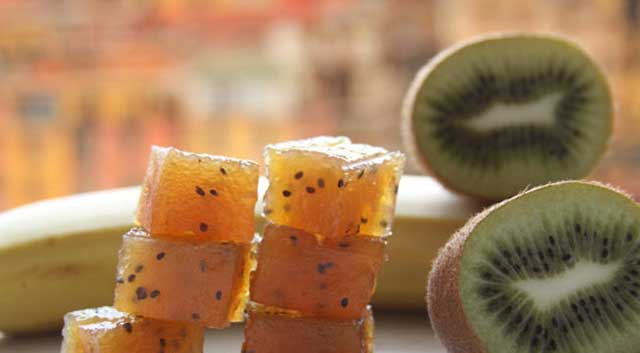
Nutritional value per 100 g:
- Calories: 56
- Proteins: 0,9
- Carbohydrates: 13,2
Ingredients for 4-5 servings
- 10 g agar
- 1 ripe sweet large banana
- 2 kiwi
- 0.5 cups of plain water.
Step-by-step preparation:
- First, simply mix agar powder and water prepared in advance. Let's boil.
- The fruits need to be peeled, cut into pieces and placed in a blender. Process into a smooth puree.
- Place the fruit mixture in a saucepan and set on gas. You don’t have to boil it if you plan to eat the marmalades within 1-2 days. If you are making “in reserve,” bring to a boil.
- Mix the fruit mixture and agar dissolved in water.
- Pour everything onto any wide plate. You can use baking sheets. Leave it on the table until it hardens.
- When it hardens, cut into cubes and the pp dessert is ready!
Benefits, harms and properties of marmalade
No one knows the exact date of creation of this natural delicacy. Some historians claim that the recipe for the fruit dessert has been known since the times of Ancient Greece, others point to the East as the birthplace of marmalade, and others attribute the authorship to the personal chef of Queen Mary Stuart of Scotland.
However, everyone agrees that this is one of the most successful desserts, when prepared correctly, and cannot harm the figure. And this is far from the only benefit of marmalade:
- The main raw materials are fruits and berries, which contain a valuable complex of vitamins and beneficial nutrients.
- Marmalade contains pectin, which is responsible for the elastic consistency of the delicacy. This polysaccharide has a positive effect on the entire gastrointestinal tract, accelerating digestion and improving peristalsis. Another useful property of pectin is it cleanses the body of toxic compounds and toxins.
- Eating marmalade allows you to regulate blood glucose levels, remove “bad” cholesterol, maintain vascular tone, accelerate intercellular metabolism and improve blood circulation.
- The substances contained in the treat have a beneficial effect on the functioning of the urinary system and the functioning of the liver and spleen.
- Fruits, and therefore marmalade, are rich in vitamin C, which is responsible for the functioning of the immune system and the body’s overall resistance to damage by viruses.
- In small quantities, this dessert can be consumed during intoxication. It is especially useful for people living in large cities, as it removes metabolic products and xenobiotics from the body.
- Classic marmalade contains virtually no fat, so it can be included in the diet.
- A dessert prepared with gelatin has a positive effect on the condition of bone tissue, stimulating its restoration, so the delicacy is useful for people with injuries to the musculoskeletal system.
- In addition to lowering cortisol, marmalade has a positive effect on the nervous system, improves memory and mental function. The dessert improves your mood and energizes you, thanks to its high content of vitamins.
- Marmalade accelerates regeneration and helps restore skin tissue after burns.
Fruit delicacy is especially useful for women, as it has a visible cosmetic effect. Regular consumption of marmalade improves the condition of the hair, making it more vibrant and giving a healthy shine, and strengthens the nail plates. Normalizing intestinal activity and removing toxins also has a positive effect on the condition of the skin.
Interesting! Dessert prepared with agar-agar is useful for diseases of the thyroid gland, as it replenishes iodine deficiency.
However, in addition to its undeniable advantages, marmalade also has a number of disadvantages. True, we are talking mainly about the store variety.
Industrially prepared dessert contains a lot of sugar, which affects its calorie content. It often exceeds the level of 300 kcal per 100 grams, so you should not use it on a diet or if you have diabetes. Among other things, store-bought marmalade can often contain preservatives, dyes and other harmful additives that can provoke an allergic reaction. Such a product is often beneficial in terms of cost, but at the same time it can harm the fragile health of children or the elderly.
Diabetics can only consume marmalade made with fructose.
How to make homemade sugar-free marmalade for diabetics?
Sweets are present in the diet of every person, including those who are faced with endocrine disorders. Considering the prevalence of the pathology, it is necessary to understand in more detail the acceptability of using marmalade for diabetics; it is also recommended to familiarize yourself with the basic recipes and what products are used at home.
Are there any benefits to marmalade?
Oddly enough, but the presented variety of dessert can really be healthy - only if natural ingredients were used in its production. Please note that:
- pectin is a plant fiber that is a health worker for the digestive system and a storehouse of vitamin components;
- gelatin is obtained by processing connective bone and cartilage tissue; includes glycine, lysine, and acids (alanine);
- Agar-agar, made from seaweed, is rich in iodine, which optimizes the activity of the endocrine gland.
Due to moderate use of the product, an improvement in intestinal motility, restoration of lipid and carbohydrate metabolism, and a decrease in the rate of cholesterol formation are identified (the likelihood of developing atherosclerosis is significantly reduced). They also pay attention to the ability to cleanse the liver and kidneys, remove toxins, and restore strength due to physical activity.
It is worthy of attention to normalize brain function, strengthen the immune system, optimize the nervous system, as well as accelerate the healing algorithm for fractures and cracks, and rejuvenate the skin. Of course, this type of sweetness is far from a panacea and does not always have a similar effect, but with the proper approach you can count on a full effect.
Is sweetness acceptable for diabetes?
Marmalade for diabetes, like marshmallows, is not a desirable product for consumption.
This applies to items that contain natural sugar - in case of a non-insulin-dependent form of the disease, they are unacceptable for consumption.
Their danger also lies in their ability to cause addiction, because a person has a constant desire to replenish the balance of serotonin (the hormone of happiness, which increases due to the appearance of sweets in the body).
Making homemade condensed milk for diabetics
At the same time, there is a special sugar-free marmalade, which is a dietary product. It replaces the natural name with substances such as fructose or xylitol.
However, the risk of developing obesity remains because the component is transformed into specific cells that accumulate in the body. To eliminate such an algorithm and the appearance of visceral problems, experts insist on dosed and rare use of dessert.
It is best to purchase varieties labeled “diabetic” or prepare them yourself, based on proven ingredients. What products to choose for homemade marmalade
It is important to know! Pharmacies have been deceiving me for so long! A cure for diabetes has been found that treats Read more…
In order to prepare a healthy dietary dish, it is advisable to use fresh fruits and berries.
The first ones are best used if they are as hard as possible, because they have the highest pectin ratio.
Those with a low glycemic index include apple (30 units), plum (22), apricot (20), pear (33), as well as black and red currants (15 and 30, respectively), and cherry plum (25).
Diabetic marmalade recipes (sugar free)
First
In general, the algorithm is as follows:
- the prepared products are placed in water, which should only cover them, and boiled for 30 minutes;
- the finished fruits are cooled, passed through a sieve or blender, and the resulting puree is placed on the lowest heat and stirred constantly to prevent the possibility of burning;
- it is important to evaporate all the liquid, after which the finished mass is laid out on a plate, having previously made ordinary balls or, for example, lozenges;
- dry the delicacy in the room until the marmalade is completely ready.
Second
Another recipe involves using berry or fruit juice. They pre-wash and sort out the unsweetened ones, squeeze out the concentrate and boil it over low heat to achieve the thickest possible jelly.
The mixture is poured onto a parchment-lined sheet and dried in the oven with the door open. At the final stage of preparation, a thin layer of marmalade remains, which is rolled into a roll and cut or squeezed out with cookie cutters.
It is recommended to store the mixture in a tightly sealed container, namely in the refrigerator.
Recipes for making ice cream for diabetics at home
Third
DIABETES IS NOT A VERDICT!
Myasnikov told the whole truth about diabetes! Diabetes will go away forever in 10 days if you drink in the morning... » read more >>>
If it is not sweet enough for a patient with an endocrine disease, then a sweetener such as stevia is used in the process of preparing the dessert. Its advantage, among other things, is its antimicrobial and antibacterial effects. To prepare the dessert you will need to use 500 g. apples, 250 gr. pears and a similar amount of plums. Wherein:
- the fruits are washed, peeled and pitted;
- chop into small cubes and fill with water so that the fruit is covered, but no more;
- after they are cooked, cool and bring to a puree consistency;
- add stevia to taste and prepare until the required thickness is obtained;
- pour into molds and wait for 100% hardening.
Fourth
The next acceptable variety involves the use of gelatin. They use the instant product, preferably a small pack. In parallel with this, the berries are crushed - be it raspberries, strawberries and others - to a puree state. Then add a small amount of water and sweeten it if desired, after which the delicacy is placed on the fire.
After waiting for it to boil, use gelatin and bring it to a boil. The name is removed from the burner, poured into molds or sockets, and placed in a cool, but not cold place.
Fifth
An unusual and tasty diabetic product is one prepared using hibiscus. The algorithm is as follows:
IT IS IMPORTANT TO KNOW!
A remedy for diabetes recommended by an experienced DIABETOLOGIST! "……………..read more >>>
I use five 5 tbsp. l. petals of the plant, water (for brewing tea) in the amount of 300 ml. You also need 25 grams. instant gelatin and sugar substitute - to taste.
The tea is brewed and gelatin is added while it steeps for swelling purposes. Then the drink is filtered and all ingredients are mixed.
Making charlotte for diabetics without sugar
The mass is brought to a boil and poured into molds. It is necessary to cool to room temperature and place in the refrigerator until completely frozen.
Sixth
The delicacy made from natural tomatoes has an excellent and very interesting taste. The procedure is carried out according to the following algorithm: two kg of tomatoes are washed, the stalks are removed and cut into small slices. The future dessert is boiled in a saucepan covered with a lid, and then ground using a sieve.
A sweetener is poured into the resulting thick juice, continuing to boil until a homogeneous mass is obtained. Then pour a thin layer onto a baking sheet and dry slightly, not for very long - it is important not to overdo it. The cooled treat is placed in the refrigerator.
Source: https://udiabetika.ru/pitanie/sladosti/marmelad-bez-sahara.html
Types of product and their calorie content
Marmalade is most often classified according to several criteria:
- by production method;
- according to form;
- by composition.
In the latter case, there are desserts made without sugar, with sugar and with fructose, as well as with pectin, agar-agar or gelatin.
As for the form and method of preparation, the most famous types are:
- Plast. Most often, this type is prepared from apples or with their participation. This fruit contains natural pectin, which thickens the fruit puree, achieving the desired consistency. Plast marmalade is considered the most useful, since during its production (fruit puree is slowly boiled with sugar until thickened) most of the vitamins are preserved. It rarely contains additional additives, and the disadvantages include its not very attractive appearance and short shelf life. Calorie content – 250 kcal.
- Jelly. Not the most healthy variety is created by combining fruit juice, sugar and various additives (dyes, flavors). Both agar-agar and pectin can be used as a thickener. The main advantage is presentation. The bright color and pleasant aroma attracts buyers, but the benefits of marmalade are minimal. Calorie content – 321 kcal.
- Chewing. A product with a very elastic consistency, which parents often use as an alternative to children's chewing gum. Made from sugar, fruit juices, additives and gelatin. Not the healthiest product due to its composition. The main advantage is a long shelf life. Calorie content – 350 kcal.
The most useful is marmalade made from fruit puree or juice, agar-agar and a minimum amount of sugar.
Types of marmalade and methods of preparation
Initially, marmalade is pieces of very thick candied jam with a gelling component. In England, “marmalade” is the name given to sweets obtained by boiling and candiing citrus fruits. Many will remember citrus slices coated in granulated sugar, which were very popular in the 90s.
Today there are a great many types of marmalade. Sweetness is made not only from berries and fruits, but also from juice, tea, spices, milk, tomatoes, alcohol and many other products.
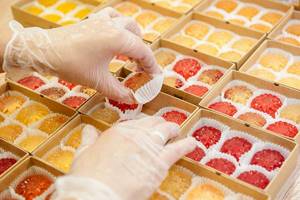
The most commonly used thickeners are:
- gelatin is a product of processing animal connective tissue;
- agar-agar is a vegetable thickener obtained from red algae;
- pectin is a polysaccharide found in all higher plants.
The recipe may also include additional ingredients - glucose syrup, molasses, wax-fat mixture (beeswax and vegetable fat).

Depending on the components used, marmalade is obtained:
- Fruit and berry – dense, with a very rich taste and “sugar” consistency. Prepared from fruit and berry puree with the addition of pectin.
- Jelly-fruit – smooth, elastic marmalade. Pectin and agar-agar are used in its preparation.
- Jelly is the softest marmalade. It is prepared from gelatin or agar.
- Chewable - stretches, does not stick to hands. Contains a wax-fat mixture, which gives it a characteristic “rubber” consistency.
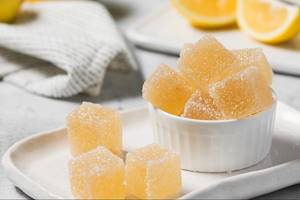
What is included in factory sweets?
When a product is manufactured under factory conditions, in addition to fruit and berry juices, a number of ingredients are added that are not considered healthy.
- Syrup. It is made on the basis of starch. Improves the consistency of marmalade, but at the same time increases its calorie content and blood sugar levels.
- Synthetic dyes. Indigo carmine, tartrazine, ponceau - all these compounds can provoke allergies, asthma attacks, and gastrointestinal diseases. These substances are especially dangerous for children, so before purchasing, you must carefully read the composition of the product.
- Sugar. Factory-made marmalade contains it in large quantities, which increases its calorie content and makes it impossible to use it during a diet. Consumption of this product by children may cause diathesis.
- Preservatives. In factory-made marmalade, calcium benzoate (E213) is most often added, which can cause allergies, or calcium sulfite (E226). This preservative is even more dangerous, since in addition to an allergic reaction, it can cause gastrointestinal upset and kidney problems.
- Artificial flavors. The pleasant fruity aroma of store-bought marmalade is often the result of a chemical compound. Synthetic flavors can cause the most harm when used regularly. They negatively affect liver function.
Important! The main goal of all artificial additives is to reduce the cost of the product. And they cope with it successfully. But such savings have the worst impact on the benefits and safety of the product.
Is it possible to buy truly low-calorie marmalade?
Proper nutrition has long been in fashion and has become one of the trends in a healthy lifestyle. Every year, many shops and restaurants open, specializing in organic products and healthy, including low-calorie dishes. You can often find fruit and berry marmalade on their shelves and on the menu.
However, before buying a product, you should take a closer look at its composition. Diet marmalade should not contain sugar or molasses. A high-quality product is prepared without the use of additives (preservatives, flavorings). Fruit-jelly sweets, made according to all the rules, will have a short shelf life and high cost, since the raw materials for one plate of classical material are required several times more than its output weight.
Low-calorie, high-quality marmalade is sold in specialized stores designed for people with a certain income level, usually concentrated in large cities. Many fans of this dessert prefer to make marmalade at home. This approach allows you to create an individual product that meets personal tastes and control the quality of the ingredients during the work.
Interesting! You can create a popular delicacy not only from the usual fruits and berries, but also from vegetables. A dessert made from pumpkin, beets and zucchini is popular in Europe.
Final tips and tricks
If you do not forget the recommendations written below, any homemade marmalade with agar-agar will turn out perfectly.
Agar from each manufacturer has its own characteristics, so read not only the recipes, but also what is written on the packages. The amount of agar may need to be increased or decreased.
The better the quality of the agar, the less it is needed. A cheaper product will use more and may have a smell. Agar is usually sold in the form of powder or flakes.
If you bought agar-agar with a slight smell of algae, add aromatic fruits and berries to the recipe. Citrus fruits perfectly cover the smell.
If the recipe calls for acidic juice (sour fruit or berries), use a little more agar - this will make it possible to get a really dense structure.
Agar must be dissolved in water or milk, followed by boiling. Juices and fruit purees can simply be heated to 70 degrees to preserve the nutrients to the maximum.
It is better to store homemade dietary marmalade for a short time - 1-2 days. If all products have been boiled, the period can be increased to 3 days.
How to make sweets at home
You can prepare delicious, bright, aromatic fruit or berry marmalade at home. To do this you will need your favorite fruits or berries. The classic recipe is apple marmalade. Earlier recipes use quince.
“Marmalade” is translated from Greek as “quince marshmallow.” It was from this fruit that the famous dessert was originally prepared.
- Apples – 2 kg.
- Lemon – 1 pc.
- Sugar – 100 gr.
- Peel the fruits, remove the seeds from the apples and cut into slices.
- Do the same with lemon.
- Place everything in a saucepan, add 50 ml of water, cover with a lid and simmer until softened.
- Remove from heat, cool and puree the fruit mixture using an immersion blender.
- Add sugar and boil the puree to the desired thickness (30-40 minutes).
- Line a baking sheet with baking paper or a silicone mat, lay out a thin layer of base and place in the oven for 2 hours at a temperature of 100°C.
- The marmalade should dry slowly and not bake.
- After time has passed, you must turn off the oven and leave the product to dry for 10-12 hours.
- Then put the dessert back in the oven for 2 hours.
After this, the finished marmalade is cut into layers, wrapped in parchment and stored in the refrigerator. The calorie content of this product is only 62 kcal.
Since apples and quinces contain pectin in sufficient quantities, which is responsible for the gelling properties of products, neither agar-agar nor gelatin are added to apple marmalade. They do this only if they want to get a treat with a denser consistency.
This recipe is suitable not only for apples, but also for quinces, pears, and peaches. At home, you can prepare real mixes from a wide variety of fruits and berries with unusual flavor notes, color and aroma. And all of them will be not only useful, but also harmless to the figure.
Important! Diet marmalade should not be rolled in sugar or powdered sugar.
“Coffee and cream” - puff diet marmalade
If you are a coffee lover, I suggest making marmalade like this. Coffee-creamy taste, amazing appearance - this treat is not a shame to serve for a holiday.
The main condition is that we brew coffee in a Turkish coffee pot or prepare it in a coffee machine; under no circumstances do we use instant coffee.
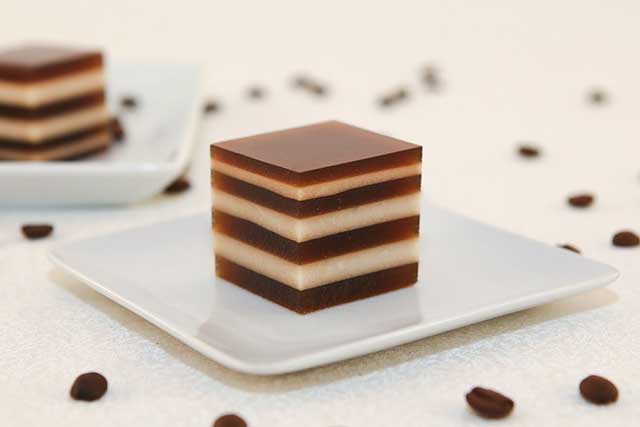
Nutritional value per 100 g:
- Calories: 26
- Proteins: 1,3
- Carbohydrates: 4,3
What you will need:
- a cup of brewed coffee without sugar or cream
- any sakhzam to taste
- cup of milk
- a little vanillin
- 2 tsp without agar agar top
How to do:
- First of all, we will make a coffee layer. To do this, you need to add sakhzam and agar to the freshly brewed coffee, but not all of it, but half - add the rest to the milk (first it needs to be heated until hot). We also add vanillin to the milk.
- We pour all the mixtures into thermoses, since we will need to keep them hot for about an hour. For what? In order to make thin beautiful layers as in the photo. The fact is that agar hardens at a temperature of about 38 degrees.
- All that remains is to pour a little at a time and wait for each layer to harden. If you don't want to bother, just do 2-4 layers.
Expert opinions
Alexey Kovalkov, famous Russian nutritionist, MD. RANS, author of books, presenter of radio and TV programs
Marshmallows, marshmallows and marmalade are some of the most harmless sweets that you can afford even on a diet, explains Dr. Kovalkov. They contain healthy pectin, a type of fiber that has a positive effect on digestion. Pectin is capable of absorbing harmful substances and removing them from the body, so in the past it was often given to people engaged in hazardous work.
Ekaterina Burlyaeva, nutritionist, candidate of medical sciences
Marmalade is often made using agar, a natural dietary fiber. Marmalade, along with marshmallows, explains Ekaterina, is not only one of the healthiest, but also low-calorie sweets. This is an excellent choice for athletes who quickly burn energy during training.
Yulia Bastrigina, doctor, nutritionist of the personal weight control program Bodykey (Nutrilite)
Marmalade made from natural juices is not only healthy, but also affordable in terms of price,” explains Yulia. It will not harm your figure and you can easily prepare it yourself.
Main conclusions
Marmalade is one of the most harmless sweets, but only if the rules for its preparation are followed.
- The main raw materials for preparing the product are fruits, berries and even vegetables.
- Eating this type of dessert improves the functioning of the gastrointestinal tract, blood circulation, and reduces the level of “bad” cholesterol and blood sugar.
- The marmalade contains vitamin complexes, beneficial nutrients and amino acids.
- It improves memory, normalizes the functioning of the nervous system and strengthens the immune system.
- The main harm lies in the additives that are used in the industrial production of the product.
- Synthetic dyes, flavors and stabilizers used in the production of cheap marmalade can lead to allergies, kidney and liver diseases.
- There are 2 main types of dessert: sheet, jelly and chewing. The most useful are plastic ones.
- You can prepare marmalade yourself at home, controlling its calorie content and composition.
Today you can buy marmalade in almost any grocery store. However, before paying, you should familiarize yourself with the composition so that the sweetness, designed to help with your diet, does not have the opposite effect.
Share your recipes for your favorite diet sweets and ways to cheer up while on a diet.
–Search by diary
–Subscription by e-mail
-Statistics
Monday, April 23, 2021 00:01 + to quote book
Homemade marmalade – 5 recipes
Marmalade is a delicious, healthy fruit dessert and aromatic oriental sweetness. In the east and the Mediterranean, the sweet was prepared from fruit purees, boiled heavily and dried in the sun. In Portugal, leaf marmalade was made from quince fruits and cut with a knife. In Germany, this is what they call any fruit jam. The true connoisseurs of marmalade are the British.
Marmalade is a low-calorie product and does not contain fat. If you are on a diet, you can make diet marmalade without sugar - fruits contain the required amount of fructose. The sweetness is rolled in sugar to reduce the moisture content of the finished product and so that it does not stick together during storage.
Marmalade at home can be made from any fruit, juice or compote, from jam or fruit puree.
Marmalade “Fruit Assortment” with pectin
To prepare the marmalade-fruit assortment, you will need silicone molds with slots in the form of slices, but you can use ordinary shallow containers, and then cut the finished marmalade into cubes.
Pectin is a natural thickener of plant origin. It is produced in the form of a grayish-white powder. It is activated by heat treatment, so when making marmalade with pectin, the solution should be heated. It can be bought at any store.
In the human body, pectin works as a soft sorbent, normalizes metabolism and has a beneficial effect on the digestive system.
The thicker the fruit puree, the less time it needs to be heated.
Cooking time – 1 hour + 2 hours for hardening.
- fresh oranges – 2 pcs;
- kiwi – 2 pcs;
- strawberries (fresh or frozen) – 400 g;
- sugar – 9-10 tbsp;
- pectin – 5-6 tbsp.
- Peel the oranges, squeeze out the juice, add 2 tablespoons of sugar and 1 tablespoon of pectin. Stir until there are no lumps.
- Pour the orange mixture into the heated pan. Stirring, heat until thick for 15 minutes, but do not boil. Cool.
- Peel and grind the kiwi in a blender, add 2 tablespoons of sugar and 1.5 tablespoons of pectin to the resulting mass. Heat the resulting mass in a separate pan, stirring constantly, until thick, 10 minutes.
- Mash the strawberries with a fork or in a blender until smooth, add 4-5 tablespoons of sugar and 2-3 tablespoons of pectin. Prepare strawberry puree like orange puree.
- You should have three containers of warm fruit puree with the consistency of thick sour cream. Grease marmalade molds with butter; silicone molds do not need to be greased. Pour the marmalade mixture into molds and place in a cool place to harden for 2-4 hours.
- When the marmalade has hardened, remove it from the molds and roll in sugar. Place on a flat plate and serve.
Homemade cherry marmalade
This gelatin recipe is easy to prepare and simple to use. You can prepare such marmalade from compotes or juices, both freshly squeezed and canned. Store gummy candies in the refrigerator.
Cooking time – 30 minutes + 2 hours for hardening.
- cherry juice – 300 ml;
- regular gelatin – 30 g;
- sugar – 6 tbsp. + 2 tbsp for sprinkling;
- juice of half a lemon.
- Dissolve gelatin in 150 ml. cherry juice at room temperature, stir and leave to swell for 30 minutes.
- Pour the remaining cherry juice over the sugar and bring to a boil, stirring. Cool the syrup a little and add lemon juice to it.
- Pour gelatin into syrup, stir until smooth.
- Fill the molds with liquid marmalade and place in the refrigerator for 1.5-2 hours to harden.
- Remove the finished marmalade from the molds and sprinkle with sugar.
Fruit marmalade with agar-agar
Agar-agar is obtained from seaweed. It is produced in the form of a yellowish powder or plates.
The gelling ability of agar-agar is higher than that of gelatin, as is the melting point. Dishes cooked with agar-agar will thicken faster and will not melt at room temperature.
Cooking time: 30 minutes + freezing time: 1 hour.
- Pour water over the agar-agar, stir and leave for 1 hour.
- Pour the agar-agar into a thick-bottomed saucepan, place over low heat and bring to a boil, stirring constantly.
- As soon as the agar-agar boils, pour sugar into it. Simmer over low heat for 1-2 minutes.
- Remove the pan from the stove and add fruit puree to the agar-agar, stirring the mixture thoroughly so that there are no lumps, cool slightly.
- Pour the finished marmalade into silicone molds of different sizes, leave to harden at room temperature or put in the refrigerator for 1 hour.
- The marmalade is ready. Cut it randomly or into different shapes, sprinkle with sugar or powdered sugar.
Apple or quince leaf marmalade
This dish does not contain gelling agents, since natural pectin is contained in apples and quinces in sufficient quantities.
If you want to make a denser marmalade, then add pectin to the fruit puree - 100 g. puree – 1 tablespoon of pectin. For apple and quince puree, pectin is needed twice as much as for fruit juices. The dish can be prepared only from apples or quince, or you can take it in equal parts.
This marmalade can be served with tea sprinkled with powdered sugar or used as a filling for buns, pies and pancakes.
This recipe will come in handy in the fall, when preparing for the winter, as this dessert can be stored for a very long time.
- Wash the apples and quince, cut into slices and remove the seeds.
- Place the apples in a deep saucepan, add water and cook, stirring, until softened.
- Cool and chop the apples in a blender or rub through a sieve. Add sugar to the puree and cook again, stirring, over low heat for 30 minutes. Cook the puree in several batches until thick.
- Line a baking sheet with parchment paper, spread a thin layer of applesauce on it and place in the oven.
- Dry the marmalade for 2 hours at 100°C, turn off the oven and leave the marmalade overnight. Do this procedure again.
- Cut the finished layer of marmalade into strips, wrap in parchment paper and store in the refrigerator.
Marmalade candies "Summer"
Any fresh berries are suitable for such sweets; if desired, you can make them from frozen fruits.
Any molds are suitable for candies, such as silicone, plastic, and ceramic.
Cooking time: 30 minutes + 1 hour for hardening.
- any seasonal berries – 500 g;
- sugar – 200 gr;
- water – 300 ml;
- agar-agar – 2-3 teaspoons.
- Wash the berries, mash with a fork or grind in a blender, add sugar and mix.
- Pour agar-agar into a saucepan, cover with cold water, and let stand for 15-30 minutes.
- Place the saucepan with agar-agar over low heat, stirring, bring to a boil, and cook for 2 minutes.
- Mix berry puree with agar-agar, cool slightly and pour into molds.
- Leave the candies to harden at room temperature or in the refrigerator for 1-1.5 hours.
We hope you, your children and your guests will enjoy these delicacies.
Apple marmalade for the winter. Apple marmalade for the winter
- Add to recipe book
- print version
- Found an error in the recipe?
You can prepare delicious apple marmalade for the winter using this recipe!
Step-by-step recipe with photos
I really love baking with apple marmalade. We don’t sell marmalade in stores, but I still want cakes and pies with marmalade, and I often make layers for cakes from apple marmalade. Several years ago I first tried to make apple marmalade for the winter at home. It turned out very tasty. Since then I often make this marmalade for future use and not only in the fall.
There are several options for making apple marmalade, but they are mainly for quick eating, not for storing for the winter. My version of marmalade lasts well in the pantry for a long time.
Let's prepare the ingredients for making apple marmalade.
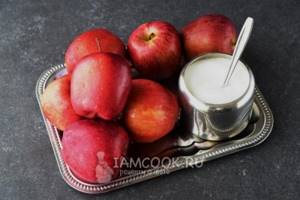
Cut the apples to remove the seed boxes. You can use a special tool to remove the core.
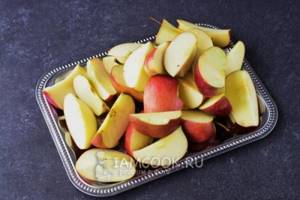
Place the chopped apples and cores in a saucepan or bowl in which you usually prepare jam. They, like the peel, are a source of pectin, which will thicken our marmalade. Add water to the pan and place the pan with apples on low heat.

Cook apples until soft for 30 minutes. Remove all pieces of apples with seed boxes.
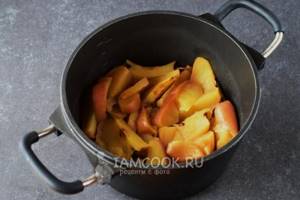
We rub the applesauce through a sieve and put it back into the pan.
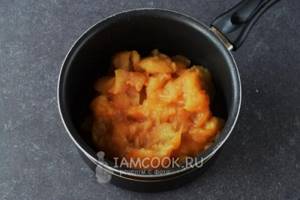
Add sugar to the puree and cook the marmalade over very low heat for 40-50 minutes.

As a result, we will get this apple marmalade.
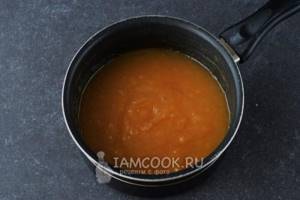
Distribute the finished apple marmalade hot into 200-250 g jars sterilized over hot steam. We roll up the jars with lids. Let the marmalade in the jars cool completely and store in the pantry.
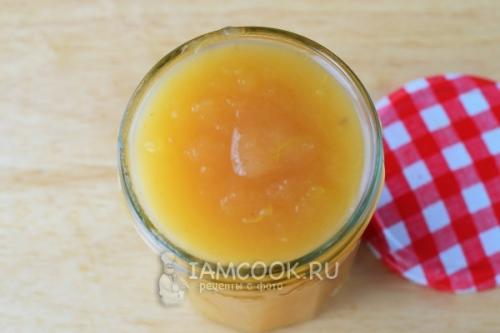
Apple marmalade for the winter is fragrant, beautiful in color and thick in consistency. After it hardens, you can cut it with a knife, it is so thick.
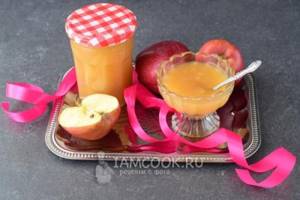
If you love baking with apple marmalade or just prefer to spread apple marmalade on a piece of toast, you'll love this recipe!
Help yourself!
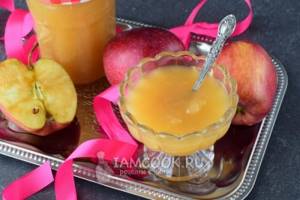
Marmalade WITHOUT sugar: recipes
Healthy eating enthusiasts are wary of eating foods containing sugar. But every person sometimes wants to treat himself to something tasty. Fortunately, today there are various sugar substitutes that do not harm the body. Any dessert
, including everyone’s favorite
marmalade, can be made without sugar. Even those who are on diets may not limit themselves to delicacies. Let's get acquainted with some recipes for healthy marmalade.
Dukan marmalade recipe
This low-calorie treat can be prepared at home. To do this, brew two hundred grams of hibiscus tea, only without sugar (if desired, you can use a little sweetener). In another bowl, dilute 2 teaspoons of agar-agar. Next, combine the mixtures, put on fire and wait until the agar-agar disperses. Pour the finished treat into molds, cool and carefully remove. This marmalade will not harm your figure and is allowed by nutritional rules, according to the Dukan diet.
Recipe for pectin marmalade with stevia
Stevia is a natural sugar substitute. Marmalade with stevia will be an excellent analogue to dessert prepared with refined sugar.
Take a kilogram of apples (it is better to use sour varieties). Cut the apples, removing the core. Apples should be boiled in a small amount of water. Make a puree from boiled apples, add stevia and put the mixture on the fire until the marmalade thickens. Pour the hot dessert into molds, cool and carefully remove.
Recipe for pear marmalade without sugar
For sugar-free pear marmalade you will need:
1 kilogram of pears,
30 grams of gelatin,
any sugar substitute - to taste,
Preparation and recipe for low-calorie sugar-free marmalade
1. Take the pears, peel them, remove the core and let them cook.
2. Pour gelatin with water, leaving until it swells.
3. Make puree from boiled pears, add sweetener and gelatin to it. Cook until gelatin dissolves.
4. Pour the marmalade into molds and cool. Delicious low-calorie marmalade is ready.
Secrets and recipe for sugar-free pectin marmalade
To prepare marmalade with pectin, you need to choose fruits and berries that contain a lot of pectin - apples, apricots, quince, gooseberries. This marmalade will take shape without adding thickeners. The pectin-based treat dries for 1 to 2 days in a cool place. This is more than gelatin or agar-agar marmalade. Instead of sugar, you can put any sweetener or honey. This marmalade is suitable for those who are on a diet and watching their figure.
The material was prepared specifically for the group’s website frufru.ru
Can't give up sweets? Make homemade marmalade!
This dessert was adored by Mary Stuart, Queen of Scotland and France. According to one legend, it was accidentally invented by a court physician and cook while trying to cure Her Majesty of a cold. As a result, the queen liked the fruit medicinal mixture.
And later - to the whole world. For example, today every second British family eats toast with this healthy and tasty delicacy for breakfast. We invite you to prepare fruit diet marmalade to surprise your loved ones with an exquisite royal dessert.
Ingredients:
- pear fruit puree – 500 g
- vanilla - pod
- agar-agar (gelatin) – 2 tsp.
- water – 200 ml
- sweetener
How to cook?
- Pour water over the agar-agar, stir and leave for 20 minutes.
- Add vanilla and sweetener to the pear puree. Then blend all ingredients in a blender until smooth.
- Place agar-agar on the fire, bring to a boil and simmer for several minutes.
- Mix agar-agar with vanilla-pear mass, mix and pour into molds.
- Place the finished diet marmalade in the refrigerator for 15 minutes (maximum time) to cool down.
Sugar free marmalade
I’m sharing my idea: a very successful homemade marmalade recipe. Jelly is prepared from agar agar and without sugar. These two facts indicate that this recipe for homemade marmalade is dietary, nothing more.
Following a diet is not a reason to deny yourself something tasty. On the contrary, to avoid breakdowns and the desire to finish your diet ahead of schedule, you should treat yourself to desserts regularly (an option for a low-calorie treat is Dietary Cottage Cheese Cake).
One of the most delicious treats is homemade agar-agar marmalade. To prepare a super dietary option, we use a sweetener. The most popular sugar substitute is stevia, but other substances can be used to add sweetness to dishes.
To get the most dietary marmalade at home, we use agar-agar. This algae powder has a slight laxative effect, perfectly helps fight hunger and satisfies well. This substance also has an important dietary quality; unlike gelatin, it contains no calories.
By preparing jelly, as well as other dietary desserts on agar, we get a dish with the same calorie content as the main product used for its preparation.
The basis for sugar-free marmalade is berry or fruit puree. In summer it can be any seasonal products, and in winter it can be prepared from frozen strawberries, cherries, and currants. Therefore, the sweeter the raw materials for preparing the dessert, the less sakhzam is needed and the tastier and more pleasant the jelly will taste.
Homemade jelly can be either single-component or multi-component, made from different berries and fruits. You can make homemade marmalade not only from puree, but also from juice; you can also find this recipe on the website.
There are other interesting recipes for healthy desserts on the site. Do not miss:
Homemade sugar-free marmalade recipe
Ingredients
Homemade marmalade calorie content per 100 g - 52 kcal
Dietary pumpkin marmalade
Delicacies and sweets can be prepared not only from berries or fruits, there are wonderful recipes from vegetables! More precisely - from pumpkin and orange.

Nutritional value per 100 g:
- Calories: 31,8
- Proteins: 1
- Carbohydrates: 7
What do you need:
- piece of pumpkin without peel and seeds - 300 g
- orange - 1 pc.
- agar-agar - 7 g
- sahzam - optional
- coconut shavings - for decoration
How to do:
- Bake or steam the pumpkin. Cool slightly and turn into puree using a blender. Add orange zest to the mixture.
- Squeeze the juice from the orange. Pour the agar into it and heat, stirring until well-hot.
- Mix warm pumpkin puree and hot orange juice.
- Pour coconut shavings into the bottom of a suitable mold, pour the future marmalades on top, and wait for it to harden.
- Then cut into pieces and enjoy!
